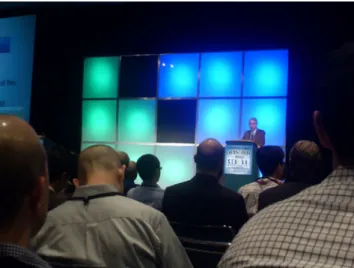CONFERENCE HIGHLIGHTS
Small – smaller – μTAS
Conni Hanke&Petra S. Dittrich
Published online: 3 March 2012 # Springer-Verlag 2012
The 15th International Conference on Miniaturized Sys-tems for Chemistry and Life Science (“μTAS”) took place at the Washington State Convention Center in Seattle, Washington (USA), from October 2–6, 2011 (Fig.1). Par-ticipants from research and industry presented and dis-cussed current contributions and research results in micro systems technology with the main focus on microfluidics. Conference topics included microfabrication, nanotechnol-ogy, integration, materials and surfaces, analysis and syn-thesis, and detection technology for all areas across life science and natural science. In particular, many presenta-tions focused on the applicapresenta-tions of microfluidics for cell biology and medical diagnostics.
The Technical Program Committee selected 694 papers (out of 1251 submitted abstracts), guaranteeing the continued high quality of contributions, which are summarized as short papers in the conference proceed-ings. More than 1100 delegates attended this year’s μTAS, chaired by James P. Landers, University of Vir-ginia, USA—a big success.
Scientific program The 102 talks and 592 posters pre-sented during the three and a half days of the conference were divided into the following main categories:
Life-science applications Microreaction applications Microfluidics fundamentals
Integrated micro and nanotechnology Nanotechnology
MEMS and NEMS technology Bench-to-bedside
Imaging and detection technology Other applications
Conference highlights The technical program was anchored by six plenary lectures given by distinguished researchers, for example Stephen Quake from Stanford University, USA, and Thomas Laurell from Lund Universtiy, Sweden, who gave insights into their latest research results. Professor Quake highlighted the problematic of linking a mutation to the correct chromosome by sequencing dip-loid genomes. His microfluidic solution is based on the amplification of individual chromosomes of single cells. Professor Laurell focused on the functionality of acous-tophoresis, the migration caused by acoustic waves (Fig.2). These standing waves can be used for contactless separation, focusing, and manipulation of microparticles and biological cells.
The program also included award ceremonies: Professor Ali Khademhosseini, Massachusetts Institute of Technology, USA, was awarded the Lab-on-a-Chip/Corning Inc. Pio-neers in Miniaturization Prize for his effort at bridging the gap between mimicking tissue in vitro and in vivo, and Professor Aaron Wheeler, University of Toronto, Canada, received the Analytical Chemistry Young Innovator Award for his work in the field of digital microfluidics. Further-more, during the two-hour poster sessions on Monday, Tuesday, and Wednesday, junior scientists had the oppor-tunity to present the results of their work. In each session 40 posters had been pre-selected for the four poster awards.
C. Hanke (*)
:
P. S. DittrichLaboratorium für Organische Chemie, HCI E 323, Wolfgang-Pauli-Str. 10, 8093 Zürich, Switzerland
e-mail: conni.hanke@org.chem.ethz.ch Anal Bioanal Chem (2012) 403:5–6 DOI 10.1007/s00216-012-5855-4
A special prize was given for the best artistic image taken during a microfluidic experiment (NIST/Lab-on-a-Chip Art in Science Award). In this category, Dong Jin Shin, John Hopkins University, USA, was awarded the prize for his “Yin and Yan in Droplets”.
Besides the scientific program, the conference organizers had planned a cultural highlight: a visit to the EMP museum (music + sci-fi + pop-culture) on Wednesday evening, which was an unforgettable and indeed unique experience during the stay in Seattle.
Future conferences The 16th International Conference on Miniaturized Systems for Chemistry and Life Sciences will take place from October 29–November 1, 2012, at the Okinawa Convention Center in Ginowan City, Okinawa, Japan.
Fig. 1 Skyline of Seattle
Fig. 2 Professor Laurell giving interesting insights into his research
